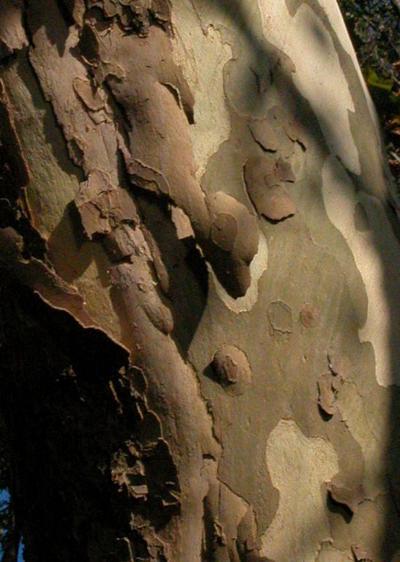Most people tend to overlook tree bark as rather uninteresting, at best. It's too bad, because bark is a fascinating and often attractive plant "invention," and is actually rather complex in its various appearances and origin. Of course, it is only developed on woody plants. Clearly, bark varies considerably from species to species, and some types of trees are easily identified by the kind of bark they have.
The bark of this tree is certainly easily recognized. It starts out quite smooth on young twigs, but as the branches grow, the bark begins to peel and crack, thus exfoliating. Irregularly-shaped, plate-like sections falling away typically reveal a beautiful mosaic of deeper bark which is white, tan and often green, forming prominent map-like patterns, much like a jigsaw puzzle. You might think, too, that such bark resembles desert camouflage.
Other than various native conifers (such as white pine and hemlock), this species is probably the largest flowering tree in eastern North America. Its leaves are relatively large, as trees' leaves go, sometimes over a foot wide, and looking something like a big maple leaf. The trees produce hundreds of tiny flowers, all compacted into a hard, rough ball, these dangling from the branches. These balls tend to break apart early in the spring, disintegrating as the seeds are released. (Now, this fruit type might be confused with those of the common sweetgum tree, but note that these are hard and somewhat spiny, falling on the ground intact.) Particularly large individual trees may be nearly 150' tall, with a trunk diameter of 12', really making it a forest giant. Old, well-formed trees usually have an impressive, rounded crown. The combination of enormous size and the unforgettable bark makes this one of the most handsome trees in America. It's a common species, too, ranging from New England into the upper Midwest, and south to Texas, Mexico, and northern Florida. It is especially common on reasonably damp soils, especially within floodplain forests, but it is quite adaptable, and also does well on high-ground sites. Because of its beauty and usefulness for shade, this tree is very popular in parks and along streets, and is commonly planted. On the other hand, this is one of those trees that is sometimes referred to as "messy," what with the falling bark, leaves and disintegrating fruits.
The photo of this tree allows me to say one or two things about birds…although I usually leave the ornithology up to someone who knows what they are talking about. You'll see on this tree's bark a series of holes, pecked or drilled by a sapsucker, probably the "Yellow-bellied" variety, Sphyrapicus varius. Now these sapsuckers don't have much sense, mindlessly pecking away and leaving an indiscriminate number of holes, in a line. But there is also a second species, Sphyrapicus mathematicus, known as the "Southern counting-bird." This species is much smarter than the sapsucker, and always pecks out the same number of holes.
[Answer: “Sycamore," Platanus occidentalis]
John Nelson is the curator of the Herbarium at the University of South Carolina, in the Department of Biological Sciences, Columbia SC 29208. As a public service, the Herbarium offers free plant identifications. For more information, visit www.herbarium.org or call 803-777-8196.








